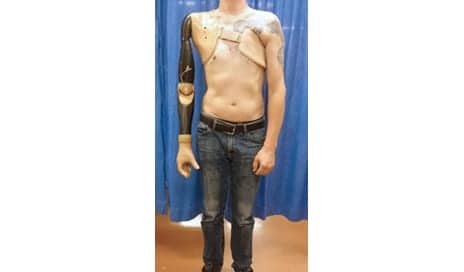
A study participant operates the sensor system and robotic prosthetic. (Photo courtesy of Imperial College London)
Imperial College London researchers announce they have developed a thought-controlled sensor technology for a robotic prosthetic arm that can be programmed to detect signals from nerves in the spinal cord.
Prosthetic control is enabled via the patient’s thoughts, which, together with the sensor technology, interprets electrical signals sent from spinal motor neurons and uses them as commands.
According to the scientists, in their study published recently in the journal Nature Biomedical Engineering, detecting signals from spinal motor neurons in parts of the body undamaged by amputation, instead of remnant muscle fiber, means that more signals can be detected by the sensors connected to the prosthetic. Ultimately, explains a media release from Imperial College London, more commands could be programmed into the robotic prosthetic, making it more functional.
“When an arm is amputated the nerve fibers and muscles are also severed, which means that it is very difficult to get meaningful signals from them to operate a prosthetic,” says researcher Dario Farina, in the release.
“We’ve tried a new approach, moving the focus from muscles to the nervous system. This means that our technology can detect and decode signals more clearly, opening up the possibility of robotic prosthetics that could be far more intuitive and useful for patients,” adds Farina, now based at Imperial College London. Per the release, he conducted the research in conjunction with co-authors in Europe, Canada, and the United States.
Six volunteers who were either amputees from the shoulder down or just above the elbow participated in the research, after undergoing a surgical procedure at the Medical University of Vienna that involved re-routing parts of their Peripheral Nervous System (PNS), connected with hand and arm movements, to healthy muscles in their body. This enabled the researchers to clearly detect the electrical signals sent from the spinal motor neurons.
The researchers created the technology by decoding and mapping some of the information in electrical signals sent from the rerouted nerve cells and then interpreting them in computer models, which were then compared to models of healthy patients. They then encoded specific motor neuron signals as commands into the design of the prosthetic, and connected a sensor patch on the muscle that had been operated on as part of the re-routing procedure, which was connected to the prosthetic, the release continues.
After working with physiotherapists so they could learn how to control the device by thinking about specific phantom arm and hand commands, the amputees were able to perform such movements as moving the elbow joint, moving the wrist from side to side, and opening and closing the hand. The researchers note that these movements are more extensive than would be possible using a classic muscle-controlled robotic prosthetic.
Further refinements are needed to make the technology more robust, but the researchers suggest the current model could be on the market in the next 3 years, the release concludes.
[Source(s): Imperial College London, Science Daily]



